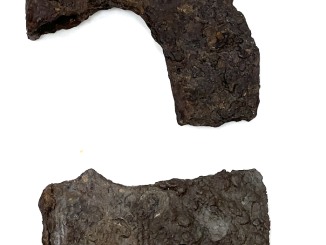On my recent trip to Finland for Finnish Brutality, I spent a few days first in Iceland, with my friend Dr. Jackson Crawford (https://www.youtube.com/c/JacksonCrawford/). Some Icelandic gun videos are coming, but we also took a moment to try out one uniquely Icelandic foods, most notably hákarl (pronounced “how-cath”). This is arctic shark buried and fermented for several months, and it has a reputation for being remarkably disgusting. We also tried harðfiskur (essentially fish jerky) and taðreyktur silungur (dung-smoked trout). Some of it was good, some was…less good, but it was all an interesting look into the diet of the Norse settlers on a pretty barren island 1200 years ago.
If you are interested in Norse language, history, and mythology, definitely check out Jackson’s channel!




This brings up the interesting topic of how humans, way back when, figured out what was safe to eat and what was not. If hákarl is toxic/deadly when fresh, then how did someone figure out the whole bury it for six months then it won’t kill you thing.
I had teacher who brought up this issue. Her take was that somebody did something terrible and was condemned to be executed for their crime. But if they ate an unknown plant/animal, and lived, they were given a reprieve for contributing to the welfare of the community by discovering a new food item.
I would like to suggest a couple of things in reference to this idea: While it seems to modern sensibilities that trying random foods and discovering how to make them safe to eat is an effort fraught with danger, the reality is that for our ancestors, starvation was pretty much a very normal state of affairs. Under that sort of incentive, you’ll try all sorts of things, and if it doesn’t kill you… Guess what? It’s part of the diet, now.
Some of the chemical processing deals like using lime to make the nutrients in corn fully accessible? I don’t think those were worked out through anything other than a combination of desperation and observation: “Oh, Matoc always puts lime on her corn, and her kids are healthy… I’ll copy her…”
We discount our ancestors observation skills and wisdom; some people even say that they were literally smarter than we are, with generally larger brain cases. Given the intricate nature of some things they processed for food, I can believe that. Taro root, anyone…?
Stupid people starved, back in the day. Today? They go down to the supermarket and buy their nutritionally-deficient processed foods, and wonder why their kids do so poorly on the standardized tests. Time was, you were dumb? You didn’t eat, you starved, your kids starved, and your genes did not get passed on into the general population. Today, the exact opposite is the case, given that the most fecund among us are also generally not the brightest lights on the Christmas tree…
I can see try anything because you are starving would happen. But it just seems that this could not account for all instances of new food being discovered. My gut feel at least. I would think people’s curiosity would drive a large portion of experimentation.
As far as the lime in the corn meal — lime is pretty nasty stuff. Why would someone just “happen” to to put that in a food item in the first place, which was later copied? Seems like there had to some more to the story.
You have lime sitting around your cave or camp site for some other reason. Some corn drops in it. You don’t have enough corn to just let it go to waste, so you take it out, try to clean it up, eat it anyway. You survive, it’s better than normal corn, bingo, new recipe, and now you experiment.
The problem with your scenario is that any improvement in health requires a continued application of the lime and time for the increased in nutrients to show an effect. It is not going to happen after just one accidental application.
Got an alternate solution, that seems more functionally possible. This is the geology scenario.
Lime is made by heating rocks composed of minerals such as calcium carbonate and magnesium carbonate. Rocks composed of these minerals, depending upon the ratio of the two carbonate minerals respectively, are called limestone and dolomite.
The lime creating process requires a temperature of 800+ degrees Celsius (https://thekidshouldseethis.com/post/making-lime-with-primitive-technology)(https://en.wikipedia.org/wiki/Lime_(material))
The heat generated by a campfire can go above 1,000 degrees (https://ibc7.org/how-hot-campfire/)
Back when, grain was ground for cooking by putting the grain between two rocks and grinding the rocks together. The stone grinding gadget is called a “metate”. (https://en.wikipedia.org/wiki/Metate) Limestone and dolomites can be quite hard and fine grained. They would make good metates.
During the grinding process, small grit is scraped off the metate and incorporated in the flour. And yes, eating the grit with your bread will, over time, wear down your teeth. This is seen in the skeletal remains of primitive groups. It took a while for humans to figure out how to minimize the amount of grit that go into the flour, but still a little gets into the flour.
So let’s say that a group of people lived in an area where limestone and dolomite were used for metates. Then also, other types of stones, like basalt, were also used for metates. The flour ground on the carbonate bearing metates included the mineral precursors of lime, which in turn was turned into lime during the cooking process, which extracted more nutrients from the corn.
Over time, the people eating bread, whose flour was ground on the carbonate bearing metates, were healthier because of long term exposure to more nutrients. This did not go unnoticed and people started trying to figure out why. Eventually, through trial and error, it was realized that the grit from the carbonate rocks was what made the food healthier. Eventually the whole intentional lime making process was discovered and adding it to the corn meal became standard cooking practice.
Another route would be that limestone and dolomite were used as rocks in a fire ring. Lime developed on the surface of the rocks and this got mixed in with the flour when a hot rock was used as a griddle. And once again the accidental, but long term health benefits, of bread cooked on one type of stone griddle, versus another type of stone griddle, would be seen and investigated.
Humans are clever enough to figure out what started as unintentional accidents.
They weren’t smarter or dumber. They just had less things to think about, thus could think more about each.
Millions of humans living over 100,000s of year do a lot of experimenting, intentional or accidental.
There’s a new Christmas tree for those who’ve seen through the recent (sounds like “psyclops”)
No needles
Just balls 😉
Try the hot dogs at Bæjarins Beztu Pylsur to make up for the fermented shark!
The preparation of the fermented shark sounds very much like the preparation of igunaaq, aged walrus, by Inuit. Cut the walrus up, sew the chunks into the walrus’ skin, bury it and let it age. Botulism isn’t too common.
When are you coming to Argentina to visit the Circulo Militar Museum ?
When are you coming to Argentina to visit the Circulo Militar Museum ?
1 dollar = 314 pesos is a very convenient exchange rate.
Back in Denmark, just after that big asteroid wiped out the dinosaurs, I went to university with a guy from Iceland. For our traditional last-day-before-the-summer-holidays celebration, he brought Icelandic fermented shark for us to try. Suffice to say, it stank up several rooms to such a degree that we could still smell it when we returned after the holidays, several weeks later.
I think the reason they eat that fermented shark is that you take a stout drink of raw spirits after each bite. It is worse than the smelly surströmming of the Swedes ….
I would reword your statement. They have nothing to eat be rotten shark because they have nothing else. After each bite, the have to cauterize their mouths with aw alcohol to be able to brave a second bite.
Makes me think: how many people died or were permanently crippled when developing these “delicacies”. Northern Europeans are in general known for their “deviant” tastes. One of common combinations in Denmark is pickled fish with honey. Thanks, I will pass on that.
Coincidently, I will have a broiled herring for dinner tonight. Yummieee!
I do like pickled fish. Particularly herring in cream sauce. But I will also pass on the honey combo.
About sharks digestive and defecating practices
https://www.dutchsharksociety.org/do-sharks-poop/#:~:text=All%20the%20shark's%20poop%20comes%20out%20via%20the%20cloaca.
there must be a reason why people eat only their fins.
Before the prices went off the chart, one of the local restaurants used to serve “shark bites”. Lightly breaded fried pieces of shark served with a mustard remoulade. Quite tasty even for those of us who find “fishy” foods disgusting.
i will never understand how or why someone would eat this or anything listed in the comments
Starvation does have a tendency to lower expectations of what is for dinner.
Long Pig.
Getting ready: surströmming and lutefisk.
[Stares in Danish horror]
“Not the worst I’ve tasted”
Perhaps surströmming?
https://www.bing.com/videos/search?q=cameron+francis+surstromming&&view=detail&mid=C907D7549009057389F9C907D7549009057389F9&&FORM=VRDGAR&ru=%2Fvideos%2Fsearch%3Fq%3Dcameron%2Bfrancis%2Bsurstromming%26FORM%3DHDRSC4